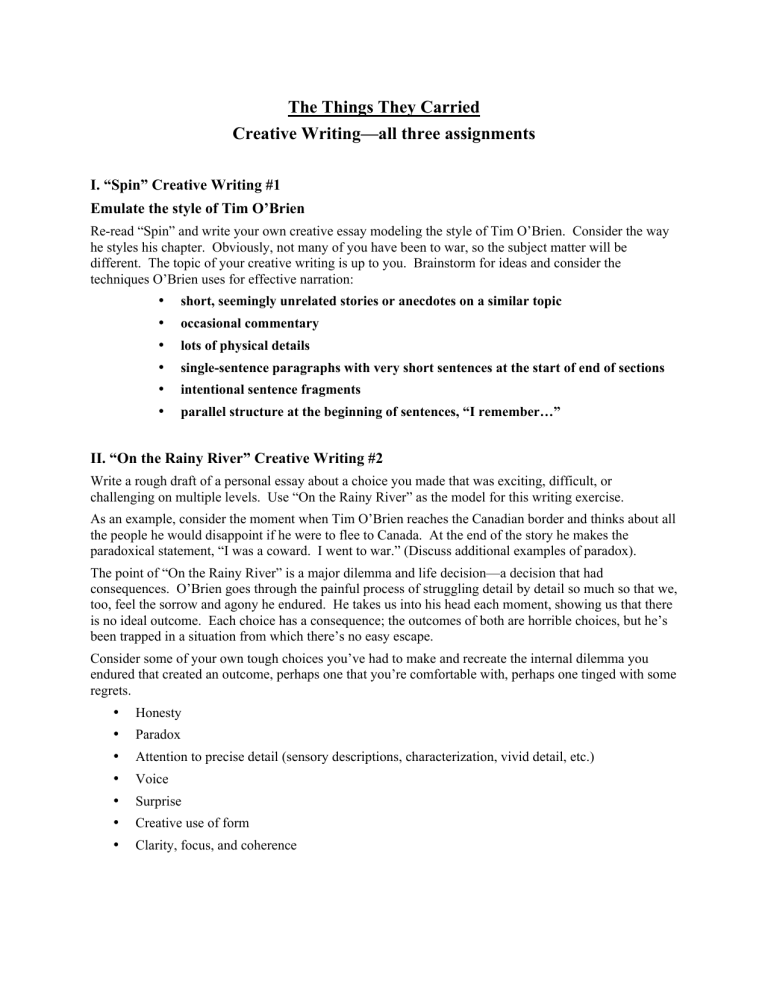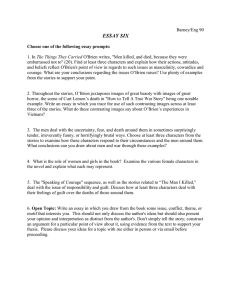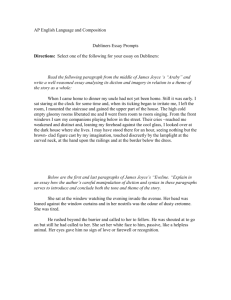
The Things They Carried Creative Writing—all three assignments I. “Spin” Creative Writing #1 Emulate the style of Tim O’Brien Re-read “Spin” and write your own creative essay modeling the style of Tim O’Brien. Consider the way he styles his chapter. Obviously, not many of you have been to war, so the subject matter will be different. The topic of your creative writing is up to you. Brainstorm for ideas and consider the techniques O’Brien uses for effective narration: • short, seemingly unrelated stories or anecdotes on a similar topic • occasional commentary • lots of physical details • single-sentence paragraphs with very short sentences at the start of end of sections • intentional sentence fragments • parallel structure at the beginning of sentences, “I remember…” II. “On the Rainy River” Creative Writing #2 Write a rough draft of a personal essay about a choice you made that was exciting, difficult, or challenging on multiple levels. Use “On the Rainy River” as the model for this writing exercise. As an example, consider the moment when Tim O’Brien reaches the Canadian border and thinks about all the people he would disappoint if he were to flee to Canada. At the end of the story he makes the paradoxical statement, “I was a coward. I went to war.” (Discuss additional examples of paradox). The point of “On the Rainy River” is a major dilemma and life decision—a decision that had consequences. O’Brien goes through the painful process of struggling detail by detail so much so that we, too, feel the sorrow and agony he endured. He takes us into his head each moment, showing us that there is no ideal outcome. Each choice has a consequence; the outcomes of both are horrible choices, but he’s been trapped in a situation from which there’s no easy escape. Consider some of your own tough choices you’ve had to make and recreate the internal dilemma you endured that created an outcome, perhaps one that you’re comfortable with, perhaps one tinged with some regrets. • Honesty • Paradox • Attention to precise detail (sensory descriptions, characterization, vivid detail, etc.) • Voice • Surprise • Creative use of form • Clarity, focus, and coherence III. “The Lives of the Dead” Creative Writing #3 The Things They Carried doesn’t end the way we expect a war story about Vietnam to end, does it? The final story takes us back to the narrator’s childhood when he experiences a personal, momentous loss, the loss of Linda, a nine-year old girl he knew and loved when he was a boy. Again, use Tim O’Brien’s writing as a model with which to explore aspects of your own life whether it’s loss or sudden change or a realization (epiphany) of some truth. Remember “The Lives of the Dead” depends on extensive physical, sensory details, not heightened emotions. The last two creative forms have involved the essay. You may select the form of this creative endeavor (poetry or prose). Basic Requirements and Due Dates: Format: Typed, double-spaced, 12 pt. font, Times New Roman, 1” margins Length requirement: Minimum of two to three typed double-spaced pages. Final draft due Tuesday, 10/4/11 The Things They Carried Creative Writing Self & Peer Revising Tips: Honesty. Real, genuine honesty about yourself, though it may be painful. However, remember that some alterations to the details (exaggeration, embellishment, simplification) are acceptable and even necessary for the sake of clarity, telling a good story, or explaining in a way that makes an impact. Interesting voice – this is important. Find your “signature” as a writer – a style that is unique to you. Avoid clichéd or overused expressions; use expressions and word choices that take the reader by surprise, making her stop and smile or stop and think (or both), and make her compelled to keep reading the essay. You might even consider modeling a master storyteller Tim O’Brien. Look at O’Brien’s multiple chapters to see how this is done. Fluency of voice. Work on smoothing out awkwardness. Streamline -- make long wordy sentences more concise. Surprises. Take the reader by surprise; don’t let the details in the essay unfold in a way that’s obvious and expected. No lazy thinking! Creative use of form. No five-paragraph formula! Play around with the ordering of your reflections, stories, observations, etc. However, don’t throw all attempts at clarity and cohesion out the window. Clarity, focus, and coherence. Short, seemingly unrelated stories or anecdotes on a similar topics interspersed throughout. Parallel structure at the beginning of sentences, “I remember…” Pacing. Control the pacing of any narrated sections very carefully. Note where you need to slow down and draw out an important moment. Sequencing. After you have a draft, look back to see if the passages are ordered effectively; if it seems sloppy and confusing, re-order, re-write, etc. until all sections are effectively transitioned from one to the next. Concreteness. Use concrete, well-selected details about your experiences to bring the writing to life. It is essential for you to show instead of merely telling. Revision. It takes time! It’s hard, but if you care at all about writing well, you have to put the time into this. Mechanics. If you are struggling with major sentence errors: fragments, run-ons, or other major grammar issues, see me right away. These errors can be seriously distracting to the content of your work. However, if you use fragments for effect, this is a different story. Make sure there’s purpose behind run-ons or fragments and supports style. The Things They Carried Creative Writing Rubric for Evaluation Please indicate which story you modeled your writing after: “Spin,” “On the Rainy River,” or “The Lives of the Dead.” • Adheres to MLA formatting guidelines: Times New Roman, 10-12 font, double spacing, two to three typed, double-spaced pages, proper heading, title if necessary. An “A” PAPER: • Is rich and creative in form and content, marked by stylistic finesse. • Your voice jumps off the page. (If you were to lose you’re essay in the hallway without your name, without a doubt, it would be returned to you). • Has an engaging title and/or opening paragraph • Has a strong closing paragraph that is thematically related to the opening (comes full circle). • Paper exhibits phrasing that is tight, fresh, and highly specific. • Provides a personal, clear, honest, and authentic voice. • Shows rather than tells (limited use of “to be” verbs). • Uses accurate and particularly vivid diction. • Short, seemingly unrelated stories or anecdotes on a similar topic • Occasional commentary and personal reflection • Varies syntax to enhance the essay’s purpose: single-sentence paragraphs with very short sentences at the start or end of sections, intentional sentence fragments, parallel structure, etc. • Has a clear tone that enhances the essay’s purpose. • Imparts a feeling of unity and clarity. • Makes the reader feel as if s/he has gotten to know the author. • Obvious evidence of revision through use of “CRISP” method (cut words, reduce clauses, intensify verbs, sharpen diction, pack phrases) or other techniques have been used. • Contains NO errors in grammar or mechanics (note: fragments, run-ons are used with purpose) A “B” PAPER: • Is significantly more than merely competent. Delivers substantial information. • Has a strong opening. Contains specific points that are ordered and unified. • Development is less specific than an A paper, but is adequate for the essay’s purpose. • Has an authentic and clear voice in places, but does not consistently develop or project that voice. • Has a closing paragraph that is thematically related to the opening. • Transitions are mostly smooth. Syntax is pleasingly varied. • Diction is fairly concise and precise, but not particularly vivid. • VERY FEW errors in grammar/mechanics. A "C" PAPER: • Is generally competent: meets the minimum terms of the assignment. • Reasonably organized. A clear organizational structure may not be fully realized. • Lacks a sense of an authentic voice, often relies on clichés or overused expressions. • Actual information often presented as vague generalities. "Telling not showing." • Often lacks specific examples, or may contain specific examples but not clarifying explanations. • Opening does not draw the reader in, closing is merely a perfunctory wrap-up. • Demonstrates a beginning awareness of transitions between paragraphs, often choppy or abrupt. • Little variation in syntax: predictable, repetitive, choppy sentences. • Diction occasionally marred by repetition, redundancy and imprecision. • Relatively free of serious grammatical/mechanical errors. A "D" or below PAPER: • Indicates an attempt to respond to the assignment. • Development unclear or completely lacking. • Confusing, unclear, or ineffective organization; often rambling. • Weak opening and closing. Repeats question in first sentence. • Vague, imprecise or inappropriate diction. • Incorrect or awkward sentence structure, often interfering with clarity of meaning. • Some serious errors in grammar/mechanics. • Evidence of careful proofreading is scanty, if non-existent • NEXT: Move to the CRISP Method devised by Dixie Dellinger, MA Cut words? R educe clauses? Intensify verbs? Sharpen diction? Pack phrases In the final edit BEFORE PROOFING: First, CUT WORDS. Cut out every word that can be spared. Remove "due to the fact that" and "in order to" and all other wordy constructions and empty expressions that don't say anything. ? Next, REDUCE CLAUSES. Almost all clauses can be reduced in some way; to appositives or phrases, etc.? Then, INTENSIFY VERBS. Circle all verbs and intensify the weak ones. This will take care of excessive use of passive voice.? After that, SHARPEN DICTION. Find the very BEST words for the audience and the purpose. Diction creates tone. ? Finally, PACK PHRASES. Move them behind the nouns. Instead of "A proposal presented by Derek Bok, the president of Harvard, was defeated," (12 words) pack it to "Harvard president Derek Bok's proposal failed." (6 words)



